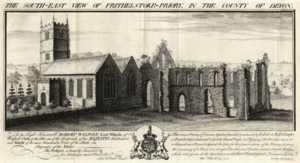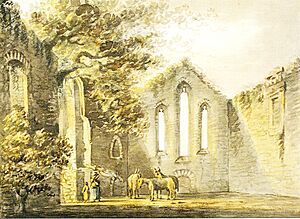Frithelstock Priory facts for kids
Frithelstock Priory was an old religious building in Frithelstock, Devon, England. It was started around 1220 by a knight named Sir Robert de Beauchamp. He built it for a group of religious men called Augustinian Canons Regular. These canons were like monks who followed strict rules. Sir Robert wanted them to pray for his soul. Walter de Stapledon, who was the Bishop of Exeter, also helped. He gave more money to the priory, so he is also seen as a co-founder.
The priory closed down in 1536. This happened during a time called the Dissolution of the Monasteries. During this time, King Henry VIII closed many monasteries and priories in England. Today, only ruins of Frithelstock Priory remain.
Contents
History of Frithelstock Priory
The Domesday Book is a very old survey from 1086. It lists Frithelstock as one of the many places owned by Robert, Count of Mortain. He was the half-brother of William the Conqueror. Later, the land was owned by Sir Roger de Beauchamp.
Around 1220, Sir Roger gave a large part of his land to the priory. He had founded this priory for the Augustinian canons. It was dedicated to Saint Gregory. The priory was also connected to Hartland Abbey in North Devon.
The Priory Closes Down
When the Dissolution of the Monasteries happened, the leader of the priory gave up the building and its lands. This was on August 27, 1536. The lands were then rented out to a man named John Wynslade.
Later, in 1537, the King leased the lands to Sir George Carew. Sir George then passed the lease to John Wynslade. However, Wynslade did not own it for long. On September 4, 1537, the King gave the priory and its lands to Arthur Plantagenet, 1st Viscount Lisle. He was an illegitimate son of King Edward IV. His wife was Honora Grenville. The estate was worth about £92 at that time. It was said that the priory and its surrounding land covered about a thousand acres.
Later Owners of the Priory Lands
The priory lands later belonged to Robert Walpole, 2nd Earl of Orford. He was the son of Robert Walpole, who was England's first prime minister. Robert Walpole's wife was Margaret Rolle. She was the daughter of Samuel Rolle, who lived at Heanton Satchville. This place was about six miles from Frithelstock.
The lands then passed down to Margaret Rolle's family. They are known as the Barons Clinton.
Frithelstock Priory in 1734
In 1734, two artists named Samuel & Nathaniel Buck made an engraving of the priory. It showed the view from the south-east. The engraving was dedicated to Robert Walpole, 2nd Earl of Orford. He was the owner of the priory at that time.
The engraving also had a description. It said that Frithelstock was a priory for Canons Regular. It was founded by Robert de Beauchamp. The priory was dedicated to God, the Virgin Mary, and Saint Gregory. It also mentioned that the priory and its land covered 1000 acres. These lands were given to Arthur Plantagenet, Viscount Lisle, when the priory closed.
A Visit to Frithelstock Priory in 1792
In October 1792, a man named Rev John Swete visited the ruins of Frithelstock Priory. He was a topographer, which means he studied and described places. He wrote about his journey in his journal.
He described the ruins as "picturesque." This means they looked very beautiful, like a painting. He noted that the western windows of the chapel were unusually rounded. The ruins mainly consisted of the side and end walls of what was then one large room. It was about 30 paces long and 9 paces wide. He also saw two very old walnut trees hanging over the southern walls. These trees, along with ivy, made the ruins even more beautiful. Rev. John Swete made a watercolor sketch of the priory from inside the ruins. It showed the view looking towards the western wall. This painting is still kept in the Devon Record Office today.






